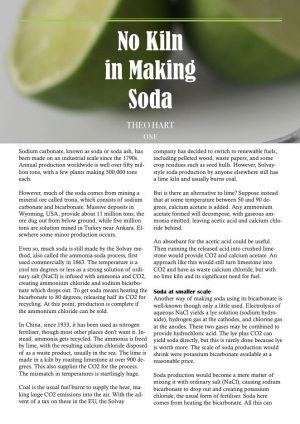 Sodium carbonate, known as soda or soda ash, has been made on an industrial scale since the 1790s. Annual production worldwide is well over fifty million tons, with a few plants making 500,000 tons each.
Sodium carbonate, known as soda or soda ash, has been made on an industrial scale since the 1790s. Annual production worldwide is well over fifty million tons, with a few plants making 500,000 tons each.
However, much of the soda comes from mining a mineral ore called trona, which consists of sodium carbonate and bicarbonate. Massive deposits in Wyoming, USA, provide about 11 million tons, the ore dug out from below ground, while five million tons are solution mined in Turkey near Ankara. Elsewhere some minor production occurs.
Even so, much soda is still made by the Solvay method, also called the ammonia-soda process, first used commercially in 1863. The temperature is a cool ten degrees or less as a strong solution of ordinary salt (NaCl) is infused with ammonia and CO2, creating ammonium chloride and sodium bicarbonate which drops out. To get soda means heating the bicarbonate to 80 degrees, releasing half its CO2 for recycling. At this point, production is complete if the ammonium chloride can be sold.
In China, since 1933, it has been used as nitrogen fertiliser, though most other places don’t want it. Instead, ammonia gets recycled. The ammonia is freed by lime, with the resulting calcium chloride disposed of as a waste product, usually in the sea. The lime is made in a kiln by roasting limestone at over 900 degrees. This also supplies the CO2 for the process.
The mismatch in temperatures is startlingly huge.
Coal is the usual fuel burnt to supply the heat, making large CO2 emissions into the air. With the advent of a tax on these in the EU, the Solvay company has decided to switch to renewable fuels, including pelleted wood, waste papers, and some crop residues such as seed hulls. However, Solvay-style soda production by anyone elsewhere still has a lime kiln and usually burns coal.
But is there an alternative to lime? Suppose instead that at some temperature between 50 and 90 degrees, calcium acetate is added. Any ammonium acetate formed will decompose, with gaseous ammonia emitted, leaving acetic acid and calcium chloride behind.
An absorbant for the acetic acid could be useful. Then running the released acid into crushed limestone would provide CO2 and calcium acetate. An approach like this would still turn limestone into CO2 and have as waste calcium chloride, but with no lime kiln and its significant need for fuel.
Soda at smaller scale
Another way of making soda using its bicarbonate is well-known though only a little used. Electrolysis of aqueous NaCl yields a lye solution (sodium hydroxide), hydrogen gas at the cathodes, and chlorine gas at the anodes. These two gases may be combined to provide hydrochloric acid. The lye plus CO2 can yield soda directly, but this is rarely done because lye is worth more. The scale of soda production would shrink were potassium bicarbonate available at a reasonable price.
Soda production would become a mere matter of mixing it with ordinary salt (NaCl), causing sodium bicarbonate to drop out and creating potassium chloride, the usual form of fertiliser. Soda here comes from heating the bicarbonate. All this can match the soda needed by a none-too-large manufacturer, who could make it and sell the fertiliser co-product.
A local maker should have a marketing advantage for a consumer product such as washing soda. It is heavy due to each crystal including ten water molecules, so a modest output could succeed.
Making Potassium Bicarbonate
Potassium bicarbonate is too soluble for the ammonia-soda process to work. Instead, the usual method is electrolysis of the chloride salt, which tends to be pricey due to the electricity needed. Regardless, electrolysis has a key role as part of a new way to work a solution potash mine, though the salt involved is not potassium chloride.
Today’s solution mining involves evaporating quite a lot of water to crystallise the potassium chloride salt brought to the surface. This consumes much fuel. Upwelled salts are mostly ordinary sodium salt, as even a rich deposit will be but 20-30% potassium chloride. A new alternative, called the ‘acetate method’, avoids this crystallisation by separating the potassium as its acetate salt, which is soluble in certain solvents that neither chloride is nor sodium acetate only slightly.
So when sodium acetate is added to the upwell, potassium may be extracted as its acetate, using ethanol, methanol or both as solvent. The potassium acetate is then contacted with a suitable amine and with CO2, which causes the formation and deposition of potassium bicarbonate, the amine attracting the acetate. After the removal of the bicarbonate, sodium hydroxide is added to strip the amine of acetate, and the sodium acetate needed in the first step is created.
As earlier depicted, sodium hydroxide (lye) may be made by electrolysis of ordinary salt, and it might have only lye and hydrochloric acid as outputs, the acid being sold. Alternatively, the electrolyser may have three sections: the anode section is fed potassium acetate resulting in potassium hydroxide being formed and H2 gas emitted, while acetate goes into the middle part; the cathode section is fed salt, chlorine gas is formed, and Na ions go into the middle part to create sodium acetate, which accumulates.
Potassium bicarbonate is made as above, as can be hydrochloric acid. In broad outline, that is the Acetate Method of potassium solution mining. In avoiding crystallisation, far less water evaporation is involved, and much less fuel is consumed. Of course, much more electricity is used, but taken together with the production of potassium bicarbonate, it is financially better, particularly for smaller-scale mines, especially where potassium is a small part of the upwell. While mines in Saskatchewan usually have 25% or so potassium in the upwell, deposits elsewhere might be less than half that.
The Acetate Method is the best option for those. Also, some deposits, too low in potassium to be mined profitably any other way, could now be brought into production.
Theo Hart




